
An ichnofacies is an assemblage of trace fossils that provides an indication of the conditions that their formative organisms inhabited.

An ichnofacies is an assemblage of trace fossils that provides an indication of the conditions that their formative organisms inhabited.
Trace fossil assemblages are far from random; the range of fossils recorded in association is constrained by the environment in which the trace-making organisms dwelt. [1] Palaeontologist Adolf Seilacher pioneered the concept of ichnofacies, whereby the state of a sedimentary system at its time of deposition could be deduced by noting the trace fossils in association with one another. [1]
Ichnofacies can provide information about water depth, salinity, turbidity and energy. In general, traces found in shallower water are vertical, those in deeper water are more horizontal and patterned. [1] This is partly because of the relative abundance of suspended food particles, such as plankton, in the shallower waters of the photic zone, and partly because vertical burrows are more secure in the turbulent conditions of shallow water. In deeper waters, there is a necessary transition to sediment feeding (extracting nutrients from the mud). [1] Food availability, hence trace type, is also controlled by energy: high energy environments keep food particles suspended, whereas in lower energy areas, food settles out evenly, and burrows will tend to spread out to cover as much area as economically as possible. [1]
Ichnofacies have a major advantage over using body fossils to gauge the same factors: body fossils can be transported, but trace fossils are always in situ. [1]
| Marine Invertebrate Ichnofacies [1] [2] [3] [4] | |||
|---|---|---|---|
| Name | Common Ichnogenera | Substrate | Inferred Paleoenvironment |
| Scoyenia [1] | Skolithos, Cruziana, Diplichnites, Rusophycus [5] | Variable - typically sandstones; red beds may be nearby | Diagnostic of terrestrial [1] /freshwater [5] facies. |
| Psilonichnus [6] | Psilonichnus, Coenobichnus, Cellicalichnus, Macanopsis [4] | Highly variable grain size, sand, soft substrate [6] | Coastal barrier islands, strand plains, delta plains, estuaries, lagoons, and bays. [4] [6] |
| Trypanites [7] | Entobia, Trypanites, Gastrochaenolites, Caulostrepsis, Maeandropolydora, Conchotrema [4] | Hardground, endurated substrates [7] | Coastal cliffs, reefs, beachrock [8] |
| Teredolites [9] [10] | Teredolites, Thalassinoides [4] | Resistant woody and coaly substrates [11] | Driftwood, peat [11] |
| Glossifungites [1] | Diplocraterion, Skolithos, Spongeliomorpha, Rhizocoralium, Arenicolites, Thalassinoides, Fuersichnus [1] [4] | Firmground, dewatered muds [1] | Shallow, marginal marine, deltaic or estuarine erosion surfaces. [1] |
| Skolithos [1] | Skolithos, Ophiomorpha, Arenicolites, Diplocraterion [1] [4] | Unconsolidated littoral sands [1] | Beaches and sandy tidal flats, shallow water, foreshore to upper-shoreface, above wavebase [1] [4] |
| Cruziana [1] | Arthrophycus, Phycodes, Rhizocorallium, Teichichnus, Arenicolites, Rosselia, Bergaueria, Thalassinoides, Lockeia, Protovirgularia, Curvolithus, Dimorphichnus, Cruziana, Rusophycus [1] [4] | Sand and silt heterolithic successions and organic detritus [4] | Mid to distal continental shelves. Below normal wave base, but not necessarily below storm wave base [1] [4] |
| Zoophycos [1] | Zoophycos, Phycosiphon, Chondrites [1] [4] | Marine softground, impure sands and silts [1] | Deeper water, bottom of shelf; turbidite facies [1] |
| Nereites [1] | Nereites, Megagrapton, Protopaleodictyon, Spirophycus, Helminthoraphe, Glockerichnus, Spiroraphe, Cosmoraphe, Urohelminthoida, Desmograpton, Paleodictyon, Scolicia [1] [4] | Fine-grained muds and clays interbedded with turbidite silts [1] [4] | Deep water, pelagic, base-of-slope turbidity systems [1] [4] |
| Vertebrate Ichnofacies [12] [13] | |||
|---|---|---|---|
| Name | Common Ichnogenera | Substrate | Inferred Paleoenvironment |
| Chelichnus [13] (Laoporus) [12] | Chelichnus, Brasilichnium [12] [13] | Unconsolidated, larger-grained sands | Aeolian sand dunes [13] |
| Grallator [12] | Grallator, Jindongornipes, Koreanoformis, Avipeda, Brachychirotherium, Rhynchosauroides, Eubrontes [12] [13] | Lacustrine shorelines [13] | |
| Brontopodus [13] | Charirichnium, Ceratopsipes, Amblydactylus, Brontopodus [13] | Clastic or carbonate [13] | Coastal plain, marine shoreline [13] |
| Batrachichnus [13] | Batrachichnus, Limnopus, Amphisauropus, Dromopus, Dimetropus, Gilmoreichnus, Chirotherium | Tidal flat-fluvial plain [13] | |
| Characichnos [13] | Characichnos, Undichna, Lunichnium, Puertollanopus, Serpentichnus, Batrachichnus, Hatcherichnus [13] | Semi-consolidated firmgrounds | Subaqueous lacustrine, estuarine, and deltaic environments [13] |
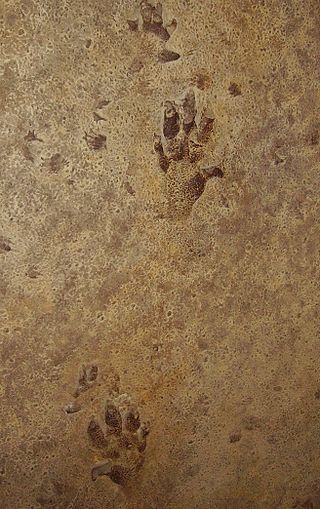
A trace fossil, also known as an ichnofossil, is a fossil record of biological activity but not the preserved remains of the plant or animal itself. Trace fossils contrast with body fossils, which are the fossilized remains of parts of organisms' bodies, usually altered by later chemical activity or mineralization. The study of such trace fossils is ichnology and is the work of ichnologists.
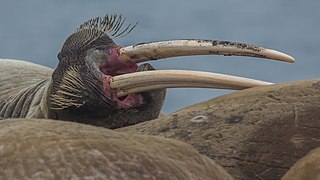
Bioturbation is defined as the reworking of soils and sediments by animals or plants. It includes burrowing, ingestion, and defecation of sediment grains. Bioturbating activities have a profound effect on the environment and are thought to be a primary driver of biodiversity. The formal study of bioturbation began in the 1800s by Charles Darwin experimenting in his garden. The disruption of aquatic sediments and terrestrial soils through bioturbating activities provides significant ecosystem services. These include the alteration of nutrients in aquatic sediment and overlying water, shelter to other species in the form of burrows in terrestrial and water ecosystems, and soil production on land.
Trace fossils are classified in various ways for different purposes. Traces can be classified taxonomically, ethologically, and toponomically, that is, according to their relationship to the surrounding sedimentary layers. Except in the rare cases where the original maker of a trace fossil can be identified with confidence, phylogenetic classification of trace fossils is an unreasonable proposition.

Adolf "Dolf" Seilacher was a German palaeontologist who worked in evolutionary and ecological palaeobiology for over 60 years. He is best known for his contributions to the study of trace fossils; constructional morphology and structuralism; biostratinomy, Lagerstätten and the Ediacaran biota.

Zoophycos is a somewhat cosmopolitan ichnogenus thought to be produced by moving and feeding polychaete worms.

The Ediacaranbiota is a taxonomic period classification that consists of all life forms that were present on Earth during the Ediacaran Period. These were enigmatic tubular and frond-shaped, mostly sessile, organisms. Trace fossils of these organisms have been found worldwide, and represent the earliest known complex multicellular organisms. The term "Ediacara biota" has received criticism from some scientists due to its alleged inconsistency, arbitrary exclusion of certain fossils, and inability to be precisely defined.

Paleodictyon is a trace fossil, usually interpreted to be a burrow, which appears in the geologic marine record beginning in the Precambrian/Early Cambrian and in modern ocean environments. Paleodictyon were first described by Giuseppe Meneghini in 1850. The origin of the trace fossil is enigmatic and numerous candidates have been proposed.
The Tumblagooda Sandstone is a geological formation deposited during the Silurian or Ordovician periods, between four and five hundred million years ago, and is now exposed on the west coast of Australia in river and coastal gorges near the tourist town of Kalbarri, Kalbarri National Park and the Murchison River gorge, straddling the boundary of the Carnarvon and Perth basins. Visible trackways are interpreted by some to be the earliest evidence of fully terrestrial animals.

Skolithos is a common trace fossil ichnogenus that is, or was originally, an approximately vertical cylindrical burrow. It is produced by a variety of organisms in shallow marine environments globally and appear as lineated features in sedimentary rocks.

The "Cambrian substrate revolution" or "Agronomic revolution", evidenced in trace fossils, is a sudden diversification of animal burrowing during the early Cambrian period.
Oldhamia is an ichnogenus describing burrows produced by worm-like organisms mining underneath microbial mats. It was common from the Early Cambrian deep-water deposits.

A microbial mat is a multi-layered sheet of microorganisms, mainly bacteria and archaea, or bacteria alone. Microbial mats grow at interfaces between different types of material, mostly on submerged or moist surfaces, but a few survive in deserts. A few are found as endosymbionts of animals.

Ophiomorpha is an ichnotaxon, usually interpreted as a burrow of an organism living in the near-shore environment. The burrow lining is more or less smooth on the inside, and densely to strongly mammalated or nodose on the outside, due to the packing of fecal pellets for support of the burrow. Branching is irregular but Y-shaped where present. It is often considered part of the Skolithos ichnofacies, where it has occurred since the early Permian, though it has also occurred in deep water settings since the Late Jurassic, such as well-oxygenated turbidites.
Macaronichnus is an ichnogenus of trace fossil.
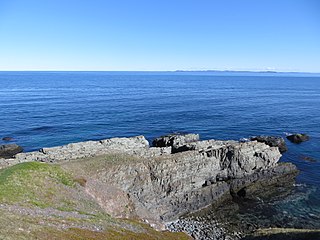
The Stratigraphy of the Cambrian period currently has several schemes used for ordering geologic formations from the period. The International Commission on Stratigraphy−ICS scheme has set a stratotype section for the base of the Cambrian, dated quite accurately to 538.8 ± 0.2 million years ago. Russian and Chinese scientists have developed a different scheme.
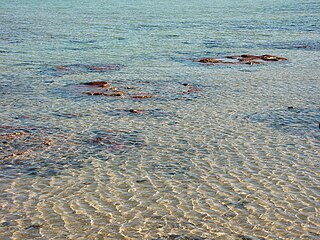
Shallow water marine environment refers to the area between the shore and deeper water, such as a reef wall or a shelf break. This environment is characterized by oceanic, geological and biological conditions, as described below. The water in this environment is shallow and clear, allowing the formation of different sedimentary structures, carbonate rocks, coral reefs, and allowing certain organisms to survive and become fossils.
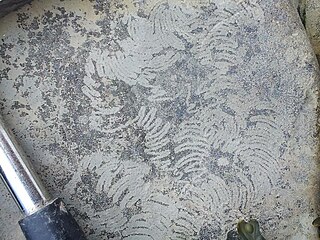
Nereites is a genus of trace fossil. Modern tracemakers of incipient Nereites include worm-like organisms, horseshoe crabs and hermit crabs. Traditionally, two models have been proposed for Nereites:

Pholad borings are tubular burrows in firm clay and soft rock that have been created by bivalve molluscs in the family Pholadidae. The common names of clams in this family are "pholads", "piddocks", and "angel wings"; the latter because their shells are white, elongated and tend to be shaped like a wing and have sculpture somewhat reminiscent of a wing.
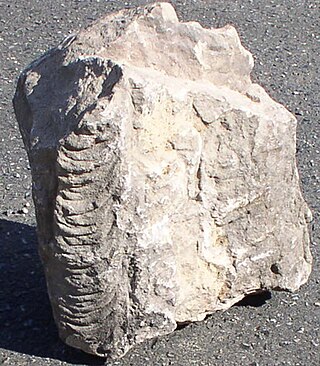
Spreite, meaning leaf-blade in German is a stacked, curved, layered structure that is characteristic of certain trace fossils. They are formed by invertebrate organisms tunneling back and forth through sediment in search of food. The organism moves perpendicularly just enough at the start of each back-and-forth pass so that it avoids reworking a previously tunneled area, thereby ensuring that it only makes feeding passes through fresh, unworked sediment.

Muensteria is the ichnogenus of a type of trace fossil that is found in sedimentary rocks, and is thought to represent the horizontal burrow of a marine invertebrate organism. It is a horizontal, non-branching, unlined, tube-like burrow characterized by menisci, which are concave to flat laminae within the burrow created as the organism packs sediment and fecal material behind it when moving forward in the burrow. Muensteria is one example of a meniscate burrow.